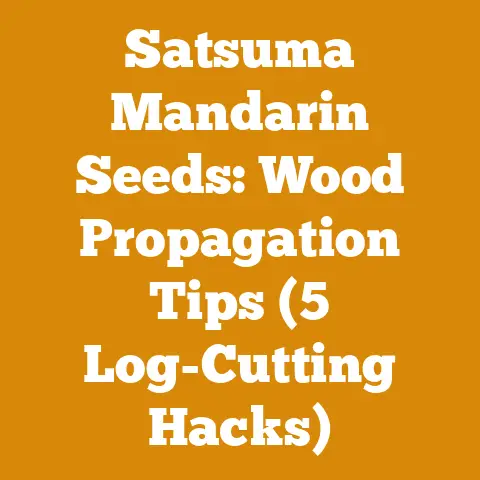Uses for Ashes in Wood Processing (7 Expert Hacks Revealed)
How to Repurpose Wood Ashes: 7 Expert Hacks Revealed
I’ve spent countless hours in the woods, felling trees, processing timber, and preparing firewood. Over the years, I’ve learned that wood processing isn’t just about cutting and splitting; it’s about respecting the resource and finding value in every part of it, even the ashes. In this guide, I’ll share seven expert hacks for using wood ashes, gleaned from my experiences and observations, to improve your wood processing and firewood preparation practices. These aren’t just theoretical ideas; they’re practical solutions I’ve personally used and refined.
Understanding Wood Ashes: A Beginner’s Guide
Before diving into the hacks, let’s establish a basic understanding of wood ashes. Wood ash is the powdery residue left after burning wood. Its composition varies depending on the type of wood burned, the burning conditions (temperature, oxygen availability), and even the soil the tree grew in. Generally, wood ash contains calcium, potassium, phosphorus, magnesium, and trace amounts of other minerals. It’s alkaline, meaning it has a pH greater than 7, and this alkalinity is key to many of its uses.
Key Terms:
- Green Wood: Freshly cut wood with a high moisture content (often above 30%).
- Seasoned Wood: Wood that has been dried to a moisture content suitable for burning (typically below 20%).
- Hardwood: Wood from deciduous trees (like oak, maple, ash) that are generally denser and burn longer.
- Softwood: Wood from coniferous trees (like pine, fir, spruce) that are generally less dense and burn faster.
The type of wood burned affects the ash composition. Hardwoods generally produce more ash than softwoods. For example, burning a cord of oak might yield significantly more ash than burning a cord of pine. The burning process also matters. A clean, hot burn will produce a finer, lighter-colored ash than a smoldering fire. For most of these hacks, I recommend using ash from clean burns of hardwoods for the best results.
Hack 1: Natural Fertilizer for Your Woodlot
Wood ash is a fantastic natural fertilizer for your woodlot or garden. The potassium and phosphorus it contains are essential nutrients for plant growth. However, it’s crucial to use it correctly.
Step-by-Step Guide:
- Test Your Soil: Before applying any fertilizer, it’s essential to test your soil’s pH and nutrient levels. A simple soil test kit from your local garden center will suffice. This will help you determine if your soil is deficient in potassium or phosphorus and if it’s already alkaline.
- Application Rate: The application rate depends on your soil test results. As a general guideline, I recommend applying no more than 10 pounds of wood ash per 100 square feet per year. It’s better to err on the side of caution, as over-application can raise the soil pH too much, harming some plants.
- Application Method: Spread the ash evenly over the soil surface and gently work it in with a rake or hoe. Avoid applying ash directly to plant stems or leaves, as it can cause burns.
- Timing: The best time to apply wood ash is in the fall or early spring, before planting or when plants are dormant. This allows the nutrients to slowly leach into the soil.
- Wood Types: Avoid using ash from treated wood, plywood, or painted wood, as these may contain harmful chemicals.
My Experience:
I’ve used wood ash to fertilize my woodlot for years. I noticed a significant improvement in the growth of my trees and shrubs, particularly those in areas with poor soil. One specific case involved a patch of struggling blueberry bushes. After applying wood ash, the bushes produced significantly more berries and showed healthier growth.
Benefits:
- Provides essential nutrients for plant growth.
- Helps raise soil pH, which is beneficial for plants that prefer alkaline soils (like blueberries, clematis, and lilacs).
- Improves soil structure.
Strategic Advantages:
- Reduces the need for synthetic fertilizers, saving you money and reducing your environmental impact.
- Supports healthy growth in your woodlot, which can increase timber yield and improve wildlife habitat.
Technical Details:
- Cost: Essentially free, as it’s a byproduct of burning wood.
- Material Specs: Use ash from clean burns of hardwoods.
- Timing Estimates: Apply in fall or early spring.
- Skill Level Required: Beginner.
Hack 2: Compost Activator
Wood ash can be a valuable addition to your compost pile. It acts as an activator, speeding up the decomposition process and adding essential minerals to the compost.
Step-by-Step Guide:
- Layering: When building your compost pile, alternate layers of “green” materials (like grass clippings, vegetable scraps) and “brown” materials (like dried leaves, shredded paper).
- Ash Addition: Sprinkle a thin layer of wood ash over each layer of “brown” materials.
- Moisture: Keep the compost pile moist but not soggy.
- Turning: Turn the compost pile regularly to aerate it and speed up decomposition.
My Experience:
I started adding wood ash to my compost pile a few years ago, and I’ve been amazed at the results. The compost breaks down much faster, and the finished product is richer in nutrients. I particularly noticed a difference when composting tough materials like corn stalks and woody branches. The wood ash seemed to help break down these materials much more quickly.
Benefits:
- Speeds up the decomposition process.
- Adds essential minerals to the compost.
- Helps neutralize acidic compost materials.
Strategic Advantages:
- Creates a nutrient-rich compost that can be used to improve soil fertility in your woodlot or garden.
- Reduces the amount of waste that goes to landfills.
Technical Details:
- Cost: Essentially free.
- Material Specs: Use ash from clean burns of hardwoods.
- Timing Estimates: Add ash whenever you add “brown” materials to the compost pile.
- Skill Level Required: Beginner.
Hack 3: Ice Melt (Emergency Use)
While not ideal for routine use, wood ash can be used as an emergency ice melt on walkways and driveways. The ash’s dark color helps absorb sunlight, which can melt ice faster.
Step-by-Step Guide:
- Application: Sprinkle a thin layer of wood ash over the icy surface.
- Safety: Be careful not to slip on the ice while applying the ash.
- Cleanup: Once the ice has melted, sweep up the ash to prevent it from being tracked indoors.
My Experience:
I’ve only used wood ash as an ice melt a couple of times, during particularly severe ice storms when I ran out of traditional ice melt. It worked surprisingly well, especially on sunny days. However, it’s important to note that wood ash can stain concrete and other surfaces, so it’s best to use it sparingly and clean it up promptly.
Benefits:
- Provides a temporary solution for melting ice.
- More environmentally friendly than some chemical ice melts.
Strategic Advantages:
- Can be a lifesaver in emergency situations when you’re out of other ice melt options.
Technical Details:
- Cost: Essentially free.
- Material Specs: Use ash from clean burns of hardwoods.
- Timing Estimates: Apply as needed during icy conditions.
- Skill Level Required: Beginner.
Important Note: Wood ash can be slippery when wet, so use caution when applying it to icy surfaces. Also, be aware that it can stain concrete and other surfaces.
Hack 4: Slug and Snail Deterrent
Wood ash can be used as a natural deterrent for slugs and snails in your garden. The ash’s alkalinity and abrasive texture irritate these pests, discouraging them from crossing it.
Step-by-Step Guide:
- Barrier Creation: Create a barrier of wood ash around vulnerable plants by sprinkling a ring of ash around the base of the plant.
- Replenishment: Replenish the barrier after rain, as the ash will wash away.
My Experience:
I’ve had good success using wood ash to deter slugs and snails from my vegetable garden. I particularly noticed a difference in the number of slugs attacking my lettuce and hostas. After applying a barrier of wood ash, the slug damage was significantly reduced.
Benefits:
- Provides a natural and non-toxic way to control slugs and snails.
- Reduces the need for chemical pesticides.
Strategic Advantages:
- Protects your plants from damage, ensuring a better harvest.
Technical Details:
- Cost: Essentially free.
- Material Specs: Use ash from clean burns of hardwoods.
- Timing Estimates: Apply as needed, especially after rain.
- Skill Level Required: Beginner.
Caution: Avoid applying wood ash directly to plant leaves, as it can cause burns.
Hack 5: Cleaning Agent for Tools
Wood ash can be used as a mild abrasive cleaner for tools, especially those with rust or grime. Its alkaline nature helps to loosen dirt and grease, while its fine particles provide a gentle scrubbing action.
Step-by-Step Guide:
- Preparation: Mix wood ash with water to form a paste.
- Application: Apply the paste to the tool and scrub with a brush or cloth.
- Rinsing: Rinse the tool thoroughly with water.
- Drying: Dry the tool completely to prevent rust.
My Experience:
I’ve used wood ash to clean my axes, shovels, and other tools for years. It’s particularly effective at removing rust and sap from chainsaw blades. I find that it works best when combined with a bit of elbow grease and a stiff brush.
Benefits:
- Provides a natural and inexpensive way to clean tools.
- Helps remove rust and grime.
Strategic Advantages:
- Extends the life of your tools by keeping them clean and well-maintained.
Technical Details:
- Cost: Essentially free.
- Material Specs: Use ash from clean burns of hardwoods.
- Timing Estimates: Clean tools as needed.
- Skill Level Required: Beginner.
Tip: For stubborn rust, try soaking the tool in a vinegar solution before cleaning it with wood ash.
Hack 6: Stabilizing Muddy Areas
In some cases, wood ash can be used to help stabilize muddy areas in your woodlot or yard. The ash’s alkaline nature can help to bind soil particles together, reducing mud and erosion.
Step-by-Step Guide:
- Application: Spread a thin layer of wood ash over the muddy area.
- Incorporation: Work the ash into the soil with a rake or shovel.
- Compaction: Compact the soil with a roller or tamper.
- Repeat: Repeat the process as needed until the area is stabilized.
My Experience:
I had a persistent muddy area near my wood shed that was constantly getting worse. After trying several other solutions, I decided to experiment with wood ash. I spread a thin layer of ash over the area and worked it into the soil. Over time, the area became noticeably drier and more stable.
Benefits:
- Helps stabilize muddy areas.
- Reduces erosion.
Strategic Advantages:
- Improves the usability of your woodlot or yard.
- Prevents soil loss.
Technical Details:
- Cost: Essentially free.
- Material Specs: Use ash from clean burns of hardwoods.
- Timing Estimates: Apply as needed during wet periods.
- Skill Level Required: Intermediate.
Important Note: This method is not suitable for all soil types. It works best on soils that are acidic and lack organic matter.
Hack 7: Fire Starter
Dry wood ash can be used as an accelerant to start fires. The fine particles increase the surface area of the fuel, making it easier to ignite.
Step-by-Step Guide:
- Preparation: Make sure the wood ash is dry.
- Application: Sprinkle a small amount of wood ash over your kindling or tinder.
- Ignition: Light the kindling or tinder.
My Experience:
I often use wood ash to start fires in my wood stove. It’s particularly helpful when the kindling is slightly damp. The ash helps to dry out the kindling and create a hotter flame, making it easier to get the fire going.
Benefits:
- Helps start fires more easily.
- Works even with slightly damp kindling.
Strategic Advantages:
- Ensures a reliable fire, especially in challenging conditions.
Technical Details:
- Cost: Essentially free.
- Material Specs: Use ash from clean burns of hardwoods.
- Timing Estimates: Use as needed when starting fires.
- Skill Level Required: Beginner.
Safety First: Always exercise caution when starting fires. Keep a fire extinguisher or water nearby. Never leave a fire unattended.
Safety Considerations When Handling Wood Ash
While wood ash is a valuable resource, it’s important to handle it safely.
- Wear gloves: Wood ash is alkaline and can irritate the skin. Wear gloves when handling it.
- Avoid inhaling dust: Wood ash can be irritating to the lungs. Wear a dust mask when handling it, especially when working with large quantities.
- Store properly: Store wood ash in a dry, airtight container to prevent it from clumping or absorbing moisture.
- Avoid contact with eyes: If wood ash gets in your eyes, rinse them thoroughly with water.
- Do not use ash from treated wood: Ash from treated wood may contain harmful chemicals.
Conclusion: Embracing the Full Potential of Wood Processing
Wood processing is more than just cutting and splitting; it’s about resourcefulness and sustainability. By embracing these seven expert hacks, you can unlock the hidden potential of wood ash and transform a waste product into a valuable resource for your woodlot, garden, and home. From fertilizing your trees to deterring pests and cleaning your tools, wood ash offers a multitude of benefits that can enhance your wood processing practices and reduce your environmental impact. So, the next time you clean out your wood stove or fireplace, don’t discard the ashes. Instead, put them to good use and experience the satisfaction of turning waste into value.
Next Steps:
- Start collecting wood ash from your wood stove or fireplace.
- Test your soil’s pH and nutrient levels.
- Choose one or two of these hacks to try out in your woodlot or garden.
- Observe the results and adjust your approach as needed.
- Share your experiences with other wood processing enthusiasts.
By implementing these strategies, you’ll be well on your way to becoming a more resourceful and sustainable wood processor. Remember, every little bit helps, and even the ashes can play a significant role in creating a healthier and more productive environment.






